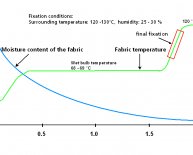
Thread dyeing process
Maya Traditions’ cooperatives in San Juan La Laguna integrate natural dyes and Ikat ties to their backstrap woven textiles, creating unique and intricate designs. Each of these techniques is traditional to Maya culture, and the region, and adds complexity and beauty to their textiles.
Naturally Dyeing Threads
This technique allows artisans to use locally found plants and insects to create vibrant colors of thread to be used in textiles. It also protects our artisans, their community and our natural surroundings by reducing the amount of synthetic chemicals involved in the dyeing process. These are the basic steps involved in the natural dyeing process:
- Preparing the Thread—Artisans use banana leaf as a natural mordent that helps the dye to set. To prepare the thread artisans first boil banana leaves for 2-3 hours and then soak the thread in the liquid to prepare them for dyeing.
- Creating the Dye—Plants or insects are cut into small pieces and then boiled for half and hour. Once the dye has reached the desired color artisans strain out the plants and insects and the dye is ready to be used.
- Dyeing the thread—The prepared threads are added to the dye and allowed to soak for anywhere to 30 minutes to 4 hours depending on the desired color.
- Drying the thread—Once the thread has reached its desired shade it is removed from the dye and allowed to dry. Once dry it is ready to be used in creation of beautiful backstrap woven textiles.
Ikat Tying and Design
Ikat—or “Jaspe” as it is known to Maya weavers—originates from the Indonesian word “Menigikat” meaning “to tie.” This traditional technique has been developed independently in many parts of the world, including: Africa, India, Indonesia, Japan, Peru, and Guatemala. The Ikat technique incorporates traditional and elaborate design elements to backstrap woven textiles. Guatemalan artisans developed “warp” Ikat, a method where only the vertical threads on the loom are dyed and feature the design.
Ikat uses a series of dye resistant knots to create designs. First, the base thread is stretched out between two posts and divided into specific sized groups. From there, artisans tie knots at pre-determined intervals to create different designs including diamonds, women, baskets, corn and dolls. Once the tying is complete the thread is dyed, usually with a natural dye, and then hung to dry. Once the thread has dried, the knots are undone and the thread is placed on the backstrap loom to create unique and intricately designed textiles.

















